
40 minute read
Water and Climate Change: World Water Day
Water and Climate Change World Water Day March 22
Article by Brianna van de Wijngaard
Advertisement
Every year, UN-Water promotes the international World Water Day campaign. World Water Day is like National Lima Bean Respect Day or National Ballpoint Pen Day, but a lot more important (no disrespect to lima beans).
The theme this year is water and climate change: like so many initiatives in the last year, the focus on curbing or minimizing climate change impacts is top of mind for environmental and human rights organizations around the world. The policy brief posted on the UNWater website summarizes the relationship between climate change mitigation measures and water as “a reciprocal one,” meaning that measures to reduce GHG emissions have a direct impact on water management and use, while management and extraction have an impact on GHG emissions due to the energy intensity of treatment and infrastructure. So, both mitigation and adaptation strategies are equally important when it comes to managing water resources and climate change impacts, and these are highlighted in the brief.
Mitigation strategies are categorized as either nature-based or technology driven. For example, one relationship between water and climate change involves heavily underutilized carbon sink opportunities. These are mangrove forests, peatlands, wetlands, and forests. These ecosystems mitigate climate change, but also require healthy, consistent hydrological cycles that are currently being affected by climate change, in addition to their lack of preservation or restoration. Maintaining or rehabilitating them is also an adaptive measure.
Another adaptation measure pointed out in the brief is the preservation of aquifers, the world’s largest source for fresh water available for human use. They are less vulnerable to climate change impacts than surface water, but because their storage capacities and recharge rates vary so widely, they must be managed comprehensively at a local level.
On average, we use 640 litres of water per day, per person, in Williams Lake, and this is without counting major industrial users. That is exactly twice the amount of the average Canadian, at 320L/day/person. In order to maintain sustainable recharge rates on our aquifer, we need to draw no more than 152L/s on average. It’s hard to say what each person’s daily use should be, but we do know from the 2019 Water Management Strategy available on the City of Williams Lake website, that our usage will approach this limit when you include industrial use, as the population increases. So, a proactive measure now, in order to stay under this average demand and put off major infrastructural investments, is to reduce our consumption. At the end of the day, 640L/day is still high, even if we currently have a healthy aquifer.
As many know, this can most easily be done during the summer months, when our water consumption peaks. But even if we reduced our outdoor summer water usage by just 20 or 25%, we would be in a much better position. We have a lot of suggestions for reducing water consumption here at the Cariboo Chilcotin Conservation Society (CCCS), but today we want to challenge city and area residents to adopt just one commitment to reducing household water consumption—and to choose something you will stick to. Starting small makes it easier to work into your daily routinebut doing so can have a huge impact on our total usageas a community. It wouldn’t take much to really strengthen our freshwater resource capacity.
I took one of the many water footprint quizzes available online, and I was actually quite surprised at my score: it wasn’t very good! These can be good tools for figuring out which part of your household consumption would benefit most from a reduction. Here’s a good one: www.watercalculator.org. We have a lot of tips for reducing your water use on our website.
We often think of a healthy water source as simply having enough water for our daily needs. And in many parts of Canada, we are lucky in that department. We are fourth on the list of the world’s “water-rich” countries, and most of us have very easy access to it in our homes, which contributes to how much we consume. But the impacts of climate change on water resources can happen anywhere, no matter how much water you have. We are lucky to be positioned to preserve what we have well into the future. -GG
Brianna van de Wijngaard is the communications coordinator for the Cariboo Chilcotin Conservation Society in Williams Lake, BC, working on various Water and Waste Wise-related projects and events in the community. Visit CCCS at www.ccconserv.org to learn more about our education programs or community projects.
o The average lawn may need about 100,000 litres of water in a growing season—avoid overwatering.
o The best time to sprinkle is in the early morning, after the dew has dried, or in the late afternoon.
o Your lawn and garden will need about 2 to 3 centimetres (1 inch) of water per week. Place a few plastic containers around your lawn during watering to measure how much has been applied.
o If you sprinkle, choose the type that spins in a circle—it will lay down water in a flat pattern in large droplets that drop to the soil surface more efficiently.
o Check sprinklers to ensure that they are moving in the proper direction and water is not being lost to runoff. Set a timer to avoid overuse.
o Take advantage of rainwater where possible. Cisterns are perfect for catching rainwater from your roof for use on your lawn or garden.
o Incorporate compost, mulch, or landscape fabric as appropriate to hold and regulate moisture in the soil.
o Set your lawnmower blades between 5 and 8 centimeters and leave the grass cuttings on the lawn as mulch, which slows evaporation of water from the soil and acts as fertilizer.
o An 8- to 15-centimeter layer of loose, organic mulch on the soil surface around plants and trees helps retain moisture and moderates soil temperature.
o If your lawn fades in the summer, do not panic. Grass becomes naturally dormant during hot, dry periods and will revive quickly after a good rainfall.
o The City of Williams Lake has a partnership with the Cariboo Conservation Society, which has developed a program called Water Wise that provides water conservation ideas and strategies.
Effective Youth Engagement in British Columbia Co-Creating a Sustainable BC
Last year, Fraser Basin Council (FBC), a province-wide charitable non-profit organization, launched a new pilot initiative to create opportunities for young people to get more deeply involved in core environmental, social, and economic sustainability issues affecting their communities. In the first year of the initiative, called Co-Creating a Sustainable BC, the organization welcomed a diverse group of youth (ages 16-30) from two regions in British Columbia: the Thompson and the Sea to Sky regions.Youth participants worked alongside each other over eight months to deepen their understanding of leadership within the context of sustainability and climate change, to identify barriers to making meaningful and lasting changes in their communities, and to practice a collaborative approach to identifying potential solutions. During the program, funding from Employment and Social Development Canada through the Canada Service Corps program allows youth to participate at no cost, with travel and meal expenses reimbursed and ASL interpreters or other accessibility needs, such as childcare, accommodated.
The Co-Creating a Sustainable BC initiative created an opportunity for young people to deepen connections to their communities, experience the benefits of being actively engaged civic participants, witness the importance of serving and contributing to a community, and learn how to embrace leadership roles. Through a series of dialogue sessions, youth heard from guest
Youth mapping out their project ideas based on a gap identified in the Thompson region. Photo: Brock Endean
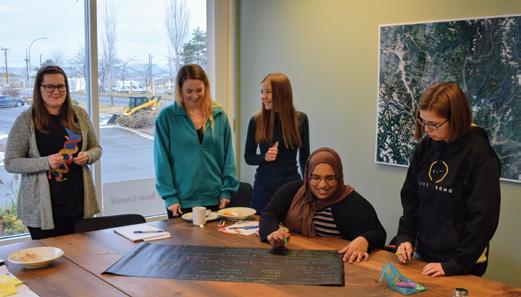
speakers who are leading way as climate and sustainability champions in different sectors, including municipal government, Indigenous communities, industry, and community organizations. Exposure to these different perspectives offered participants wellrounded knowledge about regionally specific sustainability issues and initiatives already underway in their communities. Participating youth also had the opportunity to expand their networks and create valuable connections with leaders in their communities.
Through a systematic process of identifying regional gaps and key areas for action using knowledge acquired through dialogues and skill-building sessions, youth identified and developed plans and got ready to implement sustainability projects that address a gap in the community. In alignment with FBC’s mandate, youth explored community gaps through an environmental, social, or economic sustainability lens to develop projects that address climate change. Projects in both regions are currently in the implementation phase and are expected to be completed by the end of May 2020.
As Co-Creating a Sustainable BC’s inaugural year nears its completion, the Fraser Basin Council youth team is looking forward to bringing this initiative to more BC communities in the coming year. If you are interested in learning more about the Co-Creating a Sustainable BC Initiative or in bringing it to your community, you can visit www.fraserbasin. bc.ca/youth.html or email FBC Youth Program staff youth@fraserbasin.bc.ca. -GG
Beyond Climate Ventures to the Heart of a Rapidly Heating B.C.
Article by David Suzuki

Vancouver, Canada. Image by Cornelia Schneider-Frank from Pixabay
Island Scallops on Vancouver Island has relied on stable ocean conditions since 1989. But CEO Rob Saunders says those started changing a little over a decade ago. Measurements showed dropping pH levels, indicating increased acidity. “We started to notice our larvae weren’t swimming very well,” he said. They weren’t feeding. They were dying at a tremendous rate.”
In 2013, acidity spiked near Qualicum Beach and wiped out 10 million scallops, forcing the company to rapidly adjust. Heightened acidity is a well-known consequence of CO2 dissolving into the ocean to form carbonic acid. “The focus for us now is to try as fast as we can to find something that’s going to succeed in that ocean,” Saunders says. “There’s no question that the atmospheric CO2 is increasing.”
Saunders isn’t alone in noticing accelerating effects of climate disruption. People throughout British Columbia are witnessing profound changes. Salmon runs are down as rivers get warmer, lower, or dry up altogether. Wildfires are becoming larger, more intense and frequent, threatening homes, businesses, and ways of life. Insect outbreaks once kept in check by longer, colder winters have devastated millions of hectares of forest. People in the Okanagan have been hit with the double whammy of huge wildfires and flooding from rising lake levels. Climate chaos is costing billions.
Ian Mauro, a University of Winnipeg environmental scientist, geographer, and filmmaker, explores the climate challenges and opportunities facing BC in his latest work Beyond Climate, which I narrate. This award-winning film takes the viewer past the headlines and into the heart of the issues.
From Haida Gwaii to Kelowna, Vancouver and Whistler to Mount Robson, we heard from people whose world is changing around them. Their stories of struggle and their ability to adapt in the face of massive shifts are important, so we’re offering the film for free starting February 20.
Past Haida Nation president Peter Lantin describes how low river levels from a historic drought in the archipelago affected everything from food to culture. “I think at one point it was 36 days without rain. Haida Gwaii is a rainforest, so that has huge impact on us.”
Whistler Blackcomb environmental planner Arthur Dejong says that, despite the ski resort’s high elevation, it won’t escape climate change effects. “For every degree Celsius increase, the snow line will go up 120 metres. For over a decade and a half now, we have been putting lifts higher, [with] more snow-making, more summer grooming, as part of our adaptation to a future with less snow.”
Processing and transporting fossil fuels also poses risks. Still reeling from a spill of more than 100,000 litres of fuel and other pollutants when tugboat Nathan E. Stewart sank near Bella Bella in 2016, the Heiltsuk wonder how much worse it would be if a tanker loaded with diluted bitumen were to run aground.
Salmon and other fish are being especially hard hit by fossil fuel impacts, affecting commercial and sports fishing industries, food supplies, and ways of life for coastal and inland peoples, especially Indigenous communities. Salmon also feed bears, eagles, and other animals and fertilize the magnificent coastal rainforests.
Environmental planner Stephen Sheppard connects the dots between pipelines and climate. “We’re moving massive amounts of carbon through this province, all largely invisible to people,” he says. “These are pipelines to the sky. It’s like taking carbon and sticking it in the air. Sooner or later, somewhere along the way, it gets burned. It goes up there.”
Fortunately, solutions are plentiful. In 2009, Vancouver implemented its Greenest City Action Plan. Compost programs, energyefficient buildings, district energy, reduced reliance on private automobiles—all are putting the city on track to a greener future. Vancouver has the lowest greenhouse gas emissions per person of any major North American city.
BC is the proverbial canary in the coalmine for many related issues that will define our place in the world: reconciliation with Indigenous Peoples, the clean energy transition (with concurrent continued fossil fuel development and transport), conservation, food production, changing industries, and economic priorities. Listening to people experiencing rapidly increasing climate impacts and to those doing something about the problem is critical to our understanding of how to live better in this province and on this planet. -GG
DAVID SUZUKI is a scientist, broadcaster, author, and cofounder of the David Suzuki Foundation. Written with contributions from David Suzuki Foundation senior editor, Ian Hanington. Learn more at www.davidsuzuki.org
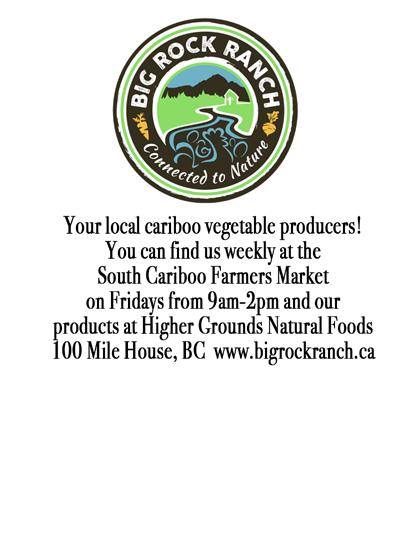
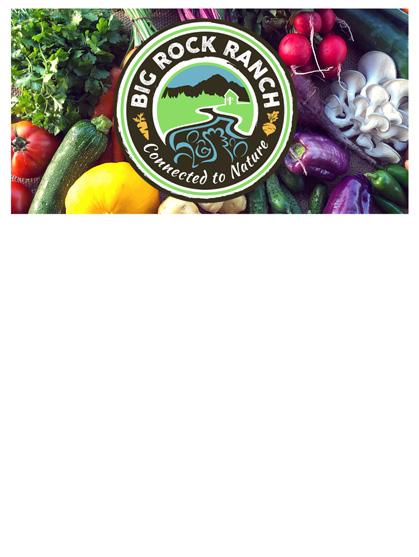








SUSTAINABLE LIVING LEADERSHIP PROGRAM SUSTAINABLE LIVING LEADERSHIP PROGRAM
Travel the mighty Fraser River, one of the world’s great salmon rivers, from Headwaters to Sea. Travel the mighty Fraser River, one of the world’s great salmon rivers, from Headwaters to Sea. Travel the mighty Fraser River, one of the world’s great salmon rivers, from Headwaters to Sea.

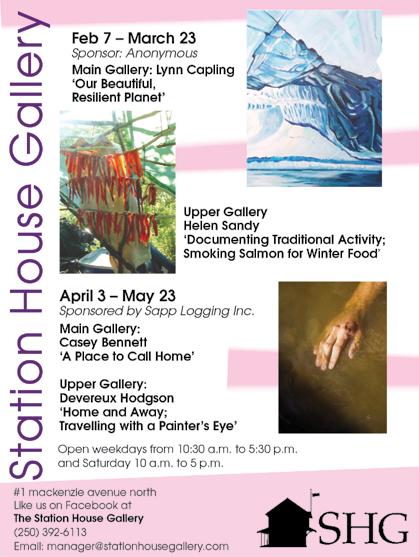
Become a Watershed Champion and help conserve, protect and restore the Fraser Watershed within this generation. Become a Watershed Champion and help conserve, protect and restore the Fraser Watershed within this generation. Become a Watershed Champion and help conserve, protect and restore the Fraser Watershed within this generation.
APPLY BY APRIL 30! APPLY BY APRIL 30!
Part of the Cariboo Regional District’s Solid Waste Info Series: Becoming Waste Wise
Article by Tera Grady
February 18 th was National Battery Day and Call2Recycle, the stewardship agency responsible for consumer battery recycling, is challenging Canadians to recycle all their old batteries.
According to the 2018 Call2Recycle consumer survey, 88 percent of British Columbians knew consumer batteries were recyclable; however, only 44 percent recycled all their batteries in 2018. This equated to a 37 percent return rate, meaning that 63 percent of batteries purchased in 2018 were not recycled.
This leads to the question—where did they all go?
If you have a drawer at home or a box that your used batteries end up in, you are not alone. Call2Recycle has identified that battery “hoarding” is one of the factors contributing to the low recycling rate for consumer batteries. The low recycling rate may also be because consumers incorrectly put batteries in their garbage or household recycling. This could be by accident or on purpose. Either way, batteries must not be disposed of in the garbage or household recycling.
During the Cariboo Regional District’s 2019 waste audit, 0.01 percent of the annual waste was attributed to lead acid batteries. That may not sound like much; yet, it adds up to over one tonne of batteries disposed at the Gibraltar landfill each year.
The good news is our recycling rate is improving. In 2018, residents in the CRD recycled 4,883 kg of consumer batteries. Per capita, that is 40 percent less than the provincial average. In 2019, though, we recycled 6,400 kg of batteries—a 30 percent increase.
But, why should you recycle your batteries? First of all, lithium or lithium-ion batteries are a leading cause of fires at both landfills and recycling facilities, which puts workers and the environment at risk.
Secondly, the hazardous chemicals and metals found in batteries can contaminate ground water and soils if disposed of improperly. If they are recycled, though, they can be used to make a variety of new products. For example: • Nickel helps make new batteries, stainless steel, coins, and electronics.
• Copper is used in appliances, mobile phones, and brass fixtures.
• Stainless steel is used for the construction of bridges and guard rails, plus everyday products including appliances, cars, trucks, stainless steel water bottles, and even pens.
• Aluminum is the most recyclable of all materials, helping create airplane parts, bicycles, aluminum cans, iPod and computer casings, and many more products.
• Cobalt and lithium are used to create new batteries. Let’s keep our momentum going in the Cariboo and recycle all old batteries in 2020. Challenge yourself, your family, and your friends to seek out all old batteries floating around households or offices and return them for recycling.
To find a drop off location, use the Call2Recycle locator on their website: www. call2recycle.ca/locator/
Learn more by following us on Facebook at facebook.com/caribooregion or visiting us online at cariboord.ca. For more information on the Waste Wise Program, call 250-398- 7929. You can also find more details on Waste Wise activities and events at www.ccconserv. org. -GG
ADD BATTERIES TO YOUR RECYCLING LIST!

Why Recycle Your Batteries? To keep harmful materials out of landfill Used batteries ending up in landfill can contain potentially toxic materials that may harm wildlifeand the environment. To keep people and property safe Responsible battery recycling practices ensure batteries are handled in a way that reduces potential fire hazards. To support sustainability Materials reclaimed from recycled batteries can be used to make new products.
About Call2Recycle Call2Recycle is your provincially regulated not-for-profit battery recycling program dedicated tothe safe collection and recycling of batteries.







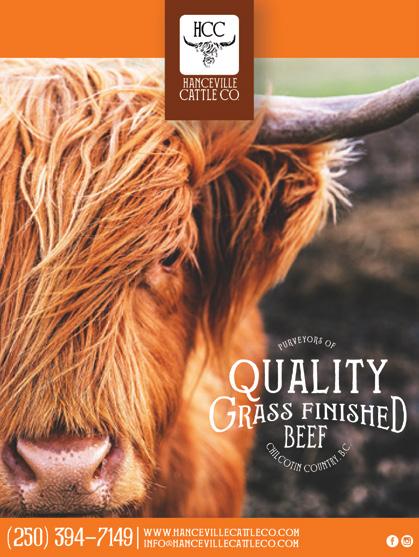
Article by Al-Lisa McKay

Follow the Rainbow Serpent. Acrylic on canvas by Al-Lisa McKay / Miss White Spider Arts
Idon’t know what you did for New Year’s eve, but I found myself cuddled up to a box of tissues and crying my eyes out watching displaced kangaroos, koalas, and bats get bandaged up from severe burns as wildfires raged across the beautiful gem of Australia. I felt so helpless and had a deep yearning to find a way to be of service.
I sent out a message on the Australian Animal Rescue Facebook page, enquiring about the possibility of there being an existing Canadian page working on behalf of Australia’s aid, and to my delight a woman replied that she had just started a Canadian page and needed administrators. I jumped on board and found myself with a new full-time volunteer job for the next three weeks.
The Canadian Animal Rescue Guild on Facebook, was created so that Canadians could get organized and help with items such as sewing, creating, designing, and recycling to make products such as joey pouches for orphaned baby kangaroos, bat wraps for orphaned baby bats, various crocheted bird nests, and other items to help animal rescue efforts in Australia. From this effort sprung different Canadian hubs where items could be dropped off, delivered to main hubs, and then flown to Australia, compliments of Air Canada.
From there items were distributed where they were most needed. The page quickly grew to over 10,000 members, creating, donating, and distributing. Canada made a big difference to many precious lives down under.
Hub and drop off locations are now closed. To everyone who jumped on board to make a difference for the cause, deep bows of respect to you, and thank you.
If anyone wants to continue to support efforts including shipping and food and medical supply costs, please visit the Canadian Animal Rescue Collective Craft Guild Go Fund Me page, which is currently accepting donations: ca.gofundme.com/f/1v1r3epw9c
As of January 2020, it was estimated that 10.3 million hectares of forest burned in Australia’s wildfires killing an estimated 1 billion animals.
I created this painting, Follow the Rainbow Serpent, with the thought of solidifying my prayers for protection for the animals, the people, and the environment. I wanted to honour the First people of Australia and their beloved ancient ancestral grounds.
The Rainbow Serpent is an immortal being and creating God in Aboriginal mythology— it is depicted in the shape of a rainbow and a snake. The connection between snake and rainbow is the bringer of water and the cycle of the seasons in life. When a rainbow is seen in the sky, it is said to be the Rainbow Serpent travelling from one waterhole to another.
In my rendition of the Rainbow Serpent, since the rainbow cannot not be seen in the sky due to smoke, the Rainbow Serpent goes underground to pull down the rains and continue to lead the animals towards safety. Spirit is all around us, it is us. According to the first peoples of Australia, an individual's entire ancestry exists as one, culminating in the idea that all worldly knowledge is accumulated through one’s ancestors.
I could explain every nuance of the painting, but I will leave the rest up to your own imagination. -GG
Al-Lisa McKay operates Miss White Spider Arts in Williams Lake, BC—a fine arts business offering workshops, travelling theater, paintings, puppets, music, dance, installation art, murals, and other fine arts. Find her on Facebook or on her website at misswhitespider. com.
Changing the World Without Burning Out What Are Your Natural Skills?
Article by Guy Dauncey
Many years ago, I lived in London, United Kingdom, in a house four us had bought together. Being self-employed, I was always on the look-out for work. My book The Unemployment Handbook had been published five years earlier, and I had acquired some skills, so I decided to set myself up as a Holistic Careers Counsellor, attracting clients by placing a brochure in a progressive church. By ‘holistic’ I meant work that would bring fulfilment and meaning. The phone started ringing, and I was in business.
I would ask my client to write a two-or-three page autobiography, and then to think back over their lives and write a paragraph each about ten things they had done that left them with a strong sense of achievement and inner pride. Could be at work, at home, on holiday— anything. I would absorb it all, then analyze their achievements using a skills chart.
The technique comes from Bernard Haldane, an American careers counsellor who was given the task in 1945 of helping returning soldiers to find civilian work at the end of World War 2. Most had no idea what they wanted to do, he found, and their resumés were more like obituaries, referring only to their past, not their future.
He realized that we have two kinds of skill— natural and acquired. You can take ten people and ask them to cook all day. At the end of the day all will be weary, but some might be good
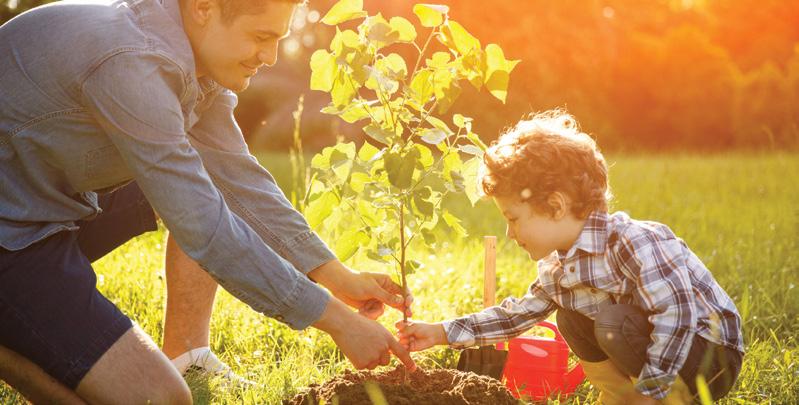
weary, because they have been using their natural skills, not just their acquired skills.
When a client arrived, I would ask them to talk about their achievements. I would share the results from the skills list, and we would explore a range of career possibilities. As we talked, I could feel the inner energy for each possibility. Let’s just say it’s one of my natural skills. It became quickly apparent which ideas were abstract and which had depth and energy. We would hone in on the one with the most energy, and I would provide advice with regard to applying for a course, getting a training, exploring the field of interest, or seeking work. After two hours, they would go away with a plan of action.
One client I remember clearly was a woman named Ellen, aged 29. Her parents were working class and had never been to college. She excelled at school and won a place at a good university. She excelled there, too, and went on to do a Masters degree, which made her parents really proud. She came to me because she felt inwardly unfulfilled, as if something was wrong.
Sitting in my attic studio she talked through her achievements, and I absorbed everything I heard. One of the achievements she was most proud of was making small wooden boxes and selling them in the Portobello Street Market. Her ten achievements told me that working with her hands was probably a natural skill, and as she spoke about this, I could feel that her enthusiasm was strong. She had felt obliged to continue with her academic career, she said, because it meant so much to her parents, but she just couldn’t continue. Together, we developed a plan that would enable her to train in woodworking, and she left on a positive, buoyant note.
Most of my clients left feeling satisfied. There were only three kinds of people I couldn’t help: those who needed personal therapy because they were sabotaging their own potential; those who didn’t have stable housing, which I quickly understood was a prior need; and those whose minds blocked out any new possibilities because what they needed more than anything was a good holiday.
Today, I wish I had time to use the same process to help people who want to find work that will make a difference in the world and help us solve the climate and ecological emergencies. There is so much that needs doing, but each of us must endeavour to find the magic place where our path of service allows us to express our natural skills, so that we can be joyful and fulfilled as we work to change the world and not get burned out. -GG
Guy Dauncey is author of The Climate Challenge: 101 Solutions to Global Warming and Journey to the Future: A Better World is Possible. Learn more at www. thepracticalutopian.ca
Article by Terri Smith | Photos by From Beds to Bowls Farm
From Beds to Bowls Garden in 2019
So much of Kate Patterson and Elliott Morton’s story of becoming farmers so closely mirrors my own that I’m afraid I kept interrupting my interview with them to exclaim and tell them bits of my own story.
As with many of us millennials, Patterson’s awareness of the dire state of our planet was with her for as long as she can remember. As early as elementary school those of us who grew up in the 80s and 90s saw how bleak our future would be if humankind continued its current path. We were all taught the importance of the three Rs, and not the three Rs our parents and grandparents were taught. Our three Rs were: Reduce, Reuse, and Recycle. We grew up with a sense of impending doom. There is a massive hole in the ozone that is damaging the planet. The amount of garbage in the oceans is staggering. Animals are going extinct at alarming rates. These facts and others like them were part of our consciousness before we were able to name the capital city of Canada or understand algebra. Most of us felt some sense of despair, and the only antidote was to try to do something about it.
So, after finishing high school Patterson enrolled at SFU where she completed a degree in environmental science. She wasn’t entirely sure what she was going to do with it until she met Morton, a kindred spirit, and they began making plans.
Morton has a degree in sustainable agriculture from UBC, and it was while in university that he realized just how much he wanted to farm. He wanted to live a sustainable lifestyle. Upon graduation, he worked on a farm in the Lower Mainland. When he met Kate, their goals became concrete plans. They would buy their own organic farm and live the sustainable lifestyle they had both longed for. “We wanted to make a difference,”
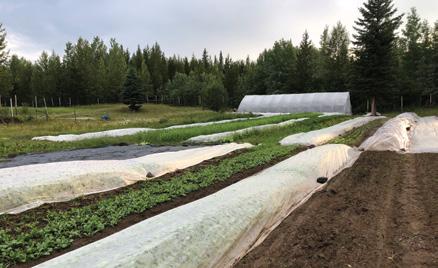
A beautiful radish selection from Kate and Elliott's stall at the Quesnel Farmer's Market
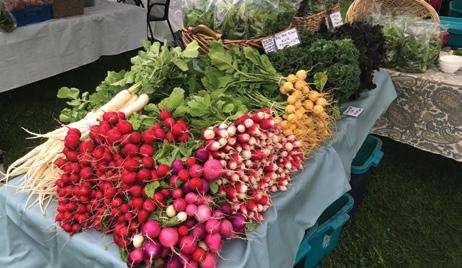
Patterson tells me. The world needs more people like them.
They worked on a few farms around the Lower Mainland for two more seasons to learn as much as they could about farming. Both had grown up in suburban environments and so really wanted to understand the lifestyle they were choosing. They loved the work and knew it was what they wanted to do.
They spent a lot of time online looking at different properties around BC to see what they might be able to afford. They wanted a place that was rural but not too far from a center where they could work and sell their produce. They found what they were looking for half an hour from Quesnel, and in May 2018 their farm, From Beds to Bowls, was born.
Their property is 10 acres and they have half an acre of garden, which will become three quarters of an acre this season.There was already a home on the property, a necessity they identified when looking at land as they both laughingly admit to not being carpenters (another thing I completely understand as my own farm became inhabited with many ‘buildings’ that were useful but would make even the most inexperienced carpenter cringe). They plan to eventually have one acre of garden in production, two acres fallow, and to produce fruit. They exclusively use organic growing methods and plan to certify in the future. They will also raise animals to make their farm as sustainable as possible. Last year they raised broiler chickens and plan to raise more this year and perhaps add weaner pigs, as well. (Again, I had to pause and exclaim for all this almost exactly describes my own farm’s growth from 2009-2012).
From Beds to Bowls specializes in salad greens of all types. They love growing specialty greens and microgreens, and their salad mixes are unique, beautiful, and tasty! They had specialized in tomatoes before moving north, and they especially love heritage varieties. They are slowly building their capacity for larger-scale tomato production. Their elevation of 900 meters makes this a slower process, but they will get there. They sell at the Quesnel Farmers’ Market and Long Table Grocery.
Patterson and Morton grow all the staple vegetables one would expect, and they really love growing different and unusual varieties— something I can relate to, as well, and we had a good-natured laugh about the ‘meat-andpotatoes’ eating habits of the Cariboo (I’m from here; I ate like this, too). But once customers sample a vegetable that may be new to them and hear from Patterson and Morton ideas of what to do with it, they usually begin to want more. It’s a slow process sometimes, since as a society we have become used to only a few types of veggies, but the calling to increase biodiversity and widen the public’s culinary horizons is a noble one. -GG
An erstwhile market gardener and mother of goat, Terri lives on a small farm near Quesnel, BC. There she gardens, makes art, writes about local food, teaches workshops, and works at Long Table Grocery as Guardian of the Vegetables.
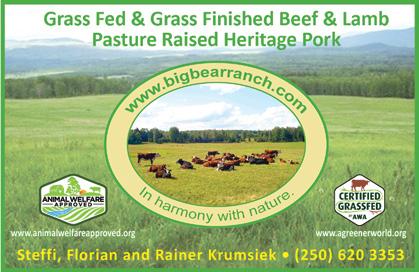
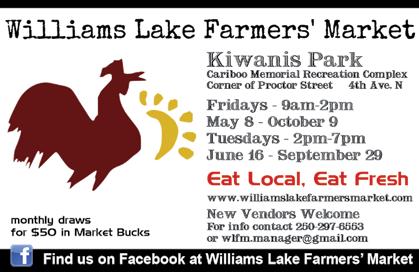


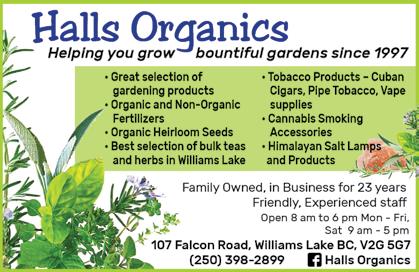



Long Table Grocery Roots of Community
Article by Amy Quarry - Owner, Long Table Grocery
“The lesson which life repeats and constantly enforces is look underfoot You are always nearer to the divine and true sources of your power than you think The lure of the distant and the difficult is deceptive The great opportunity is where you are Do not despise your own place and hour Every place is under the stars Every place is the centre of the world.” —John Burroughs T his winter marks 18 years since I returned to Quesnel after living away in the city, and every year I find myself reckoning with the choices that have led me to put down roots here. I’ve always been the restless type of soul, and I still find it somewhat startling that I have become planted in one place. From the time I was very small I was determined to be a National Geographic photographer as it was my favourite thing to read. As a young person living in a small town, I was determined to hit the city as soon as I could and never look back.
But, as you may have experienced yourself, life sometimes has a funny way of giving us what we need rather than what we think we want, and I have most definitely fully landed here, happily investing my life in a particular place, in a particular way that is inextricably tied to this community and the people in it.
Even though I never envisioned myself putting down roots this way, investing in community building and place-making now feels more like a safe container that supports my ability to fully experience growth and selfawareness than a restriction, and surprisingly to me, within this commitment is where I’m finding the freedom to become the fullest version of myself. That freedom is something I always thought I would find when I one day had the time and money to travel more or move somewhere more exciting, but it turns out knowing and being known (for better and worse) and really sinking down roots in community and learning how to actively participate in building it has been one of the most rewarding and challenging processes of my life. I have learned many significant lessons in the process, a few of which I would like to share with you here:
How to Build Community
1. Make room at the table for everyone—we all have a role to play.
2. Stay open and curious—ask questions and listen to the answers.
3. Collaborate instead of compete—a rising tide lifts all boats.
4. Share resources—even if all you have is your time.
5. Eat meals together—food is the universal connector.
6. Invest in local businesses, ideas, and organizations.
7. Remember small does not mean insignificant.
8. Be a connector—introduce people to each other.
9. Make time and space for joy, art, and laughter.
10.Speak up and tell the truth—as Brene Brown says, “Clear is kind.”
Participating in community and choosing to be rooted together with others is not always the easiest path, but in my experience the rewards always outweigh the risks. We live in a time in which real-world connections and real-time experiences matter immensely, and doing everything we can do to improve the quality of our relationships with people and the land is critical to building thriving and resilient communities that will grow forward with abundance into the future. -GG
Amy Quarry is an entrepreneur, communitybuilder, maker, graphic designer, and localist. She loves her small town and strongly believes in the resilience of a community built together.
Long Table Grocery is a locally-owned independent food hub providing good food that is sustainably sourced and locally-rooted in the Cariboo region of BC. As well as providing biweekly subscription Harvest Boxes, Long Table
Grocery operates a fresh food grocery and low-waste cafe and hosts cooking workshops and community-based food events throughout the year. It is the company’s goal that shopping at Long Table Local is easy, convenient, and a meaningful way to make your purchasing dollars count towards building a more food-secure community for all. Long Table Grocery currently works with more than 40 North Cariboo farmers and food producers, growing community through food.

Super Crucifer Salad
From the Long Table Grocery Kitchen

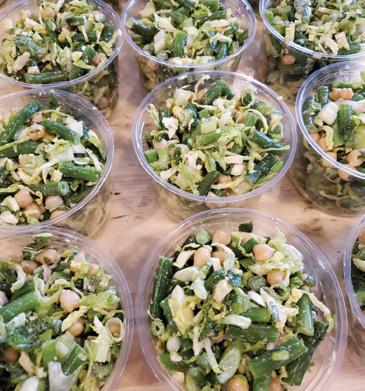
INGREDIENTS:
THE SALAD 135 g chickpeas, soaked and cooked 80 g broccoli florets or green beans 60 g brussel sprouts, de-stemmed and julienned 1/2 bunch green onions 1/2 bunch cilantro, roughly chopped 70 g celery, diced
THE DRESSING 10 g ginger, grated 35 ml lime juice 60 ml avocado oil 20 g honey 1/4 tsp salt
METHOD:
1. Mix salad ingredients together 2. Mix dressing ingredients together 3. Toss salad in dressing and serve. Serves 4.
Stephen Pellizzari NOTARY PUBLIC
Cariboo Mall 575 Alder Avenue
Box 2105, 100 Mile House, BC V0K 2E0

Stephen Pellizzari NOTARY PUBLIC
Earth Memories Earth Day April 22
Article by Tim Vant
Ihave fond memories of growing up in the Cariboo region—as a child, running through birch leaves and admiring the papery bark and the myriad of colours brought on by leaves, wildflowers, and grasses. Every bumblebee was a delight, and every fuzzy black and orange caterpillar a new joyful discovery.
Today, the same stand of birch trees we played in has been chopped down to make way for development. Are there better ways to preserve existing greenspace as Earth day turns 50 this year? As plastic production and consumption ramp up to unprecedented levels can we, at a community level, combat this trend with initiatives to reduce plastic use? What can we do to ensure clean air and water for our community in the next 50 years? These are a few questions worthy of reflection, not just on April 22 but every day.
While Earth Day didn’t go global until the 1990s it has been around since the 1970s, and it is credited with providing the necessary momentum to bring about environmental protection legislation. The now world-wide event motivates massive citizen walk-outs and demonstrations to raise environmental awareness. The theme for Earth Day 2020 is climate action and will include climate strikes around the world. Looking around Cariboo towns it isapparent we also have a litter problem, not just in urban areas either. A hiker can see discarded pop cans, coffee lids, and plastic bottles even in less traversed areas. Please make the effort to pack out what you bring in if you are visiting the forest.
There is much to celebrate on this Earth day despite the challenges. Awareness is growing. Volunteers are banding together to pick up litter in the great global cleanup. More and more shoppers are bringing their own multiple-use bags regularly. More families are composting at home and feeding the soil in their neighbourhood. Shoppers are questioning retailers on packaging that is unnecessary or that could employ a compostable option. Every year, local conservation organizers motivate students with Earth Day challenges to keep environment education and participation alive.
On this 50th anniversary of Earth Day, various people in Williams Lake and area are also banding together to plan several Earth Day events, including a climate strike and march, garbage pick-up challenge, and a prayer/energy healing for the Earth. Stay tuned on the details as these and other activities are organized. Visit the Williams Lake Climate Action Coalition Facebook page or wlclimateactioncoalition.com or watch the local papers and city pages for activities. Also, check out earthday.org for activities in the area and all over the world. Volunteer help with these or other related events would be appreciated.
Whatever activities you find on April 22, do take a moment to enjoy the beauty of nature that we still have and reflect. Earth is our home and a living, breathing reminder that every day is Earth Day. -GG Tim Vant is a multi-disciplinary artist, editor, and author who has been involved in several different forms of expression. He has traversed many different mediums and artistic forms throughout the years. On this 50th anniversary of Earth Day, various people in Williams Lake and area are also banding together to plan several Earth Day events, including a climate strike and march, garbage pickup challenge, and a prayer/energy healing for the Earth.



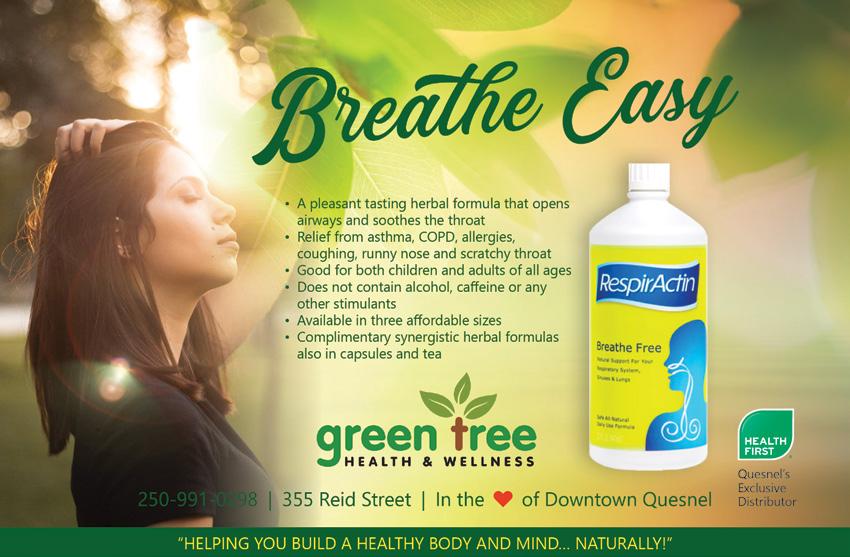

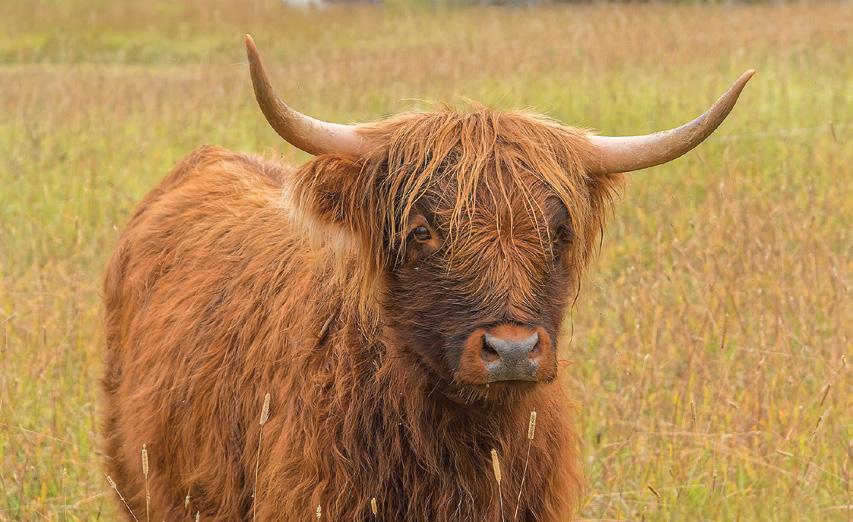
Ranching with Heart and Vision from the Soil Up
Eclipse is a registered Highland heifer, and is part of the land restoration team at SW 2 Ranch. Photo: Ivan Hardwick
Beautiful, nutrient-dense, healthy, and organically-fed meat is available from SW² Ranch, where owners Sherry and Shawn Wiebe practise regenerative agriculture, ensuring that the soil sustains the animals and the animals sustain the soil, contributing to a strong, diverse ecosystem.
Located on Bells Lake Road near Horsefly, BC, the 220-acre ranch is surrounded by Crown land and produces organically-fed pasture pork and free-range chickens for both meat and eggs, as well as grass-fed-andfinished Highland cattle for meat and breeding stock. All the meat they sell is processed at a provincially inspected facility.
They usually run between 25-40 head of Highland cattle.
Shawn was raised on a hobby farm and Sherry was raised on a commercial pig farm. The practices they have put into place on their own ranch are vastly different from the ones she grew up with. Sherry’s experience with animals has gone from night to day: from cattle prods and chutes to open pastures and animals treated with kindness.
“It just seemed wrong—the tail docking and tooth clipping, the farrowing crates and being raised in cement tight quarters where they
Article by LeRae Haynes
can hardly move,” she explained. “Our animals here are treated with respect and humanity, and I love watching them, knowing that they have amazing lives.”
They buy and mill organic grain every week for their chickens and pigs so it’s as fresh as possible.
Shawn and Sherry started out on a 26- acre farm in Vernon where their agriculture learning adventures began. Shawn says they had a small orchard with overgrown and neglected trees.
“We fenced it off and put chickens in it,” he said.“This reduced the insect problem, greatly improved the health of the trees, and protected the chickens. It solved problems naturally rather than chemically.”
Four years ago, when they needed a bigger place, they moved to Bells Lake.
Shawn said he always wanted Highland cows. “My dad died of a heart attack at 58 on a diet of commercial meat,” he said. “We wanted to make healthier choices. Highland beef is lower in cholesterol and fat and higher in protein and iron than most other beef.
“We also like their characteristics,” he added.“For the most part they’re docile, they’re very good foragers, and they have great longevity.” He said when they moved to Bells Lake, they purchased some haying equipment, but sold it within two years. “Hay was too expensive to grow, plus the land needed nutrients put into the soil,” he explained.“We bought hay instead, and now our main hayfield is a 70- acre pasture.”
They use temporary grazing cells divided by electric fencing. “The cattle get fresh grass, and at the same time they’re putting nutrients into the soil,” he said.“We don’t let the cattle over-graze down to where the parasites are and haven’t had to deworm them for several years.
“When you deworm them, the manure doesn’t break down. The birds and the bugs won’t touch it, and the nutrients don’t make it into the soil.”
Their chickens are in chicken tractors and get moved around every day. Their nitrogenrich manure is great for the soil.
Another way that the soil is enriched on SW² Ranch is the way they feed their cattle.
In the winter they put round bales on the ground for the cows—enough to last for a week. They place it in different locations, spreading the fiber and manure from place to place.

“We don’t unroll the big bales; the cows take them apart,” Shawn said. “In one area after bale feeding, the weeds were gone and there was knee-high clover. Improved soil conditions mean that weeds won’t come back, but the grasses will.”
He added that water is key. “You want water to stay in the soil as long as possible,” he said. “Good soil holds the water.”
Responsible husbandry and humanity are top priorities on the ranch. The cows, 100% grass-fed, are handled stress-free. When they move the cows, they don’t chase them. They lay out hay, and the cows follow. The calves are weaned naturally at seven or eight months with no stress.
Calving starts in May, when the cows are getting the most nutrition from the grass—no ice, no snow, no cold.
Sherry and Shawn sell direct to consumers. Along with an established customer base throughout the Okanagan they are expanding their clientele in the Cariboo Region and deliver regularly. Their butcher is near Little Fort, and most of the meat is stored in a commercial freezer in Armstrong.
Highland beef is a dense, beautiful meat that does not shrink when cooked, and has a high nutrient content, Shawn said.
“We started out feeding and sustaining ourselves holistically and it’s grown to this,” Sherry said, adding that people thought they were crazy along the way.
Shawn stated that one of the biggest things for him is seeing the improvements to the land and the benefits to the ecosystem. “Species of birds have returned, and we’ve seen increased beetles and dragonflies—from soil organisms to cattle and all the way to pollinators,” he said.
“We love where we live. It’s a beautiful, quiet, awesome life.” For more information about SW² Ranch, visit their page on Facebook, email info@sw2ranch.ca or phone (250) 620-0548. Their very lean 100 per cent grass-fed ground beef is available at Long Table Grocery in Quesnel, BC. -GG


LeRae Haynes is a freelance writer, song writer, and instigator of lots of music with people of all ages in the community. She fearlessly owns 10 ukuleles, clinging to the belief that you’re not a hoarder if you play them all.









